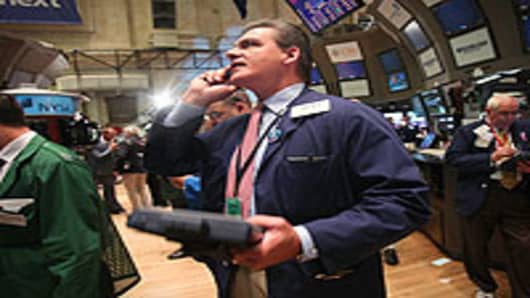Traders expect October to give the markets a scare, starting with news on the economy and jobs in the week ahead.
After a surprisingly good performance in the third quarter, the thinking is the stock market is ready to pull back, especially after a few choppy sessions and a new batch of data that should continue to show a slow-moving, ‘zombie like’ economy. (Read More: September Bad for Stocks? Why It's Different This Time)
Stocks logged the best third quarter performance since 2010. For the quarter, the Dow surged 4.32 percent and the S&P 500 soared 5.76 percent.
The coming week could provide plenty of excuses to take profits, beginning with Monday’s ISM manufacturing data, again expected to show weakness in the sector.
Manufacturing reports from China, over the weekend, and from Europe, also Monday, will provide a look at just how sluggish global activity has become. (Read More: Stocks to Ward Off China Slump?)
Friday’s jobs report is expected to show the low level of job creation continued in September, after August’s 96,000 nonfarm payrolls. The U.S. election is also a focus this week, with the first presidential debate in the tight race Wednesday evening.
“I think the overarching thing is it’s the new quarter. What’s it mean? Did we experience any window dressing? It doesn’t feel like it to me,” said Art Hogan of Lazard Capital Partners. “To me, there’s more downside risk than upside risk.”
“I’m not sure what the catalyst is going to be, but we’re due,” said Hogan. (Read More: S&P 500 to Hit Record High in 2013—Strategist)
Counterbalancing the disappointing economic news has been the willingness of global central banks to take action, and the Fed’s quantitative easing programis expected to provide a floor for the market if it does start to correct.
Of interest will be Fed Chairman Ben Bernanke’s comments Monday on the economy before the Economic Club of Indiana. The European Central Bank also holds a rates meeting Thursday, and while it is not expected to act, ECB President Mario Draghi will hold a briefing afterwards.
“Because of quantitative easing and we know the Fed’s going to be doing QE for a while, I think that takes some of the sting out of the economic data,” said Marc Chandler, chief currency strategist at Brown Brothers Harriman. The Fed’s latest program is open ended and takes aim at the housing market, with the purchase of $40 billion in mortgage securities per month.
Chandler said he expects the dollar to gain some traction, around the economic data this week, and because of Fed easing. “We’re moving to a ‘risk off’ environment,” he said.
While the data has been disappointing, some of it has not, including housing and some consumer-related readings. University of Michigan consumer sentiment, for instance, was revised down from 79.2 to 78.3 in the final September report, but interestingly, the expectations of consumers rose, and consumer confidence, reported in the past week, also improved.
“I think the auto sales next week could be kind of interesting. We do have strong auto sales. They’re probably closer to the average for the full year. We haven’t seen deterioration yet. The personal consumption data is still holding up pretty well,” Chandler said.
Auto sales are reported Tuesday. Truecar.com expects car sales rose 11 percent from last year to 1.2 million, for a seasonally adjust selling rate of 14.6 million compared to 14.5 million in August.
The jobs number could also show these mixed economic messages—a weaker manufacturing sector and a consumer showing some signs of life. Retail hiring, for instance, could add to the jobs number, putting it at about 130,000 for the private sector, according to Diane Swonk, chief economist at Mesirow Financial.
“Retailers are hiring but we’re going to be losing some Wall Street people by the end of the week. There’s going to be some cross currents,” she said. The Chicago teachers’ strike, now resolved, could also have impacted the number by about 20,000, she said. Swonk expects total nonfarm payrolls, including public sector layoffs, to total 110,000.
She also sees third quarter growth at a soft 1.6 percent, after second quarter revisions in the past week showed that period grew at just 1.3 percent.
Wells Fargo institutional equity strategist Gina Martin Adams said she is actually more interested in the ISM manufacturing number than jobs this week. “I’ve been more focused on the ISM report just because the manufacturing sector seems to be at the leading edge of the decline,” she said.
“I’m looking for a positive ISM to be one of the signs of a turnaround…I don’t think we’ll get it next week,” she said. The reading was 49.6 last month, and a number below 50 shows contraction.
“I think jobs are important to the economic landscape but maybe just simply because the Fed is going to back stop until they improve,” said Adams.
Edging Toward Fiscal Cliff
The outcome of the electionand the resulting handling of the so-called “fiscal cliff” are seen as keys to the performance of markets in the fourth quarter, and to the economic outlook.
Fiscal cliff is used to describe the double whammy to the economy that could come from the dual expiration of Bush-era tax cuts and automatic spending cuts Jan. 1, if the lame duck Congress does not act. The outcome on taxes and spending is expected to be different, depending on who wins the White House and Senate in November.
“The number of times we’re going to see the candidates and hear about the candidates’ platforms does increase as you get closer and closer to the election so it does become more central to the market’s concerns,” said Adams. “I just think at this particular time, we have earnings right around the corner, and with the situations with Greece and Span.. There’s just so many macro issues to deal with. The election is one, not first and foremost.”
Hogan said the market is currently pricing in status quo with a Democratic White House and Senate, but that could change when President Barack Obama and Republican Mitt Romney are face-to-face Wednesday.
“If the opinion on the results of the election changes because of the debate, it could be a market moving event,” said Hogan. “If there’s an upside surprise in Mitt Romney’s performance here, and you see the spreads in the pivotal states tick up a bit, I think the market looks at that as a positive.”
The Republican ticket is widely favored on Wall Street, since Romney’s stand on taxes and spending are viewed as more favorable for the economy and markets. A Republican sweep, while not apparent in the polls, would also be expected to bring a swifter resolution to the fiscal cliff.
What to Watch
Monday
0830 am Chicago Fed President Charles Evans with CNBC’s Steve Liesman on “Squawk Box”
1000 am ISM manufacturing
1000 am Construction spending
1200 pm San Francisco Fed President John Williams makes opening remarks comments at capital markets conference
1230 pm Fed Chairman Ben Bernanke speaks on economy, takes questions at Indiana Economics Club
Tuesday
Earnings: Mosaic, Acuity Brands
September vehicle sales
Wednesday
Earnings: Family Dollar, Monsanto, Marriott
0815 am ADP employment
1000 am ISM nonmanufacturing
0200 pm FOMC minutes
0745 pm St. Louis Fed President James Bullard on monetary policy
first presidential debate
Thursday
Earnings: International Speedway
Chain stores September sales
0830 am Initial claims
1000 am Factory orders
Friday
Earnings: Constellation Brands
0830 am Employment report
0100 pm Fed Gov. Elizabeth Duke on real estate at New York Fed
0300 pm Consumer credit
Follow Patti Domm on Twitter: @pattidomm
Questions? Comments? Email us at marketinsider@cnbc.com




